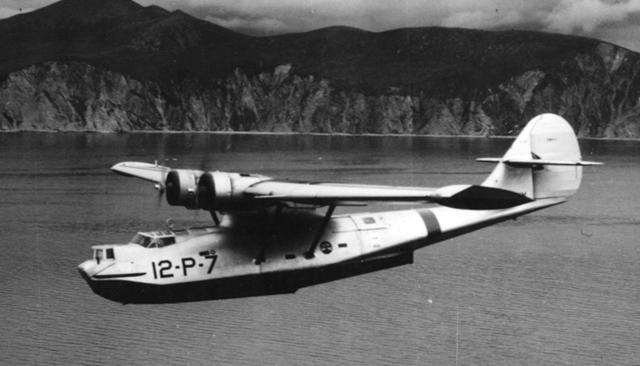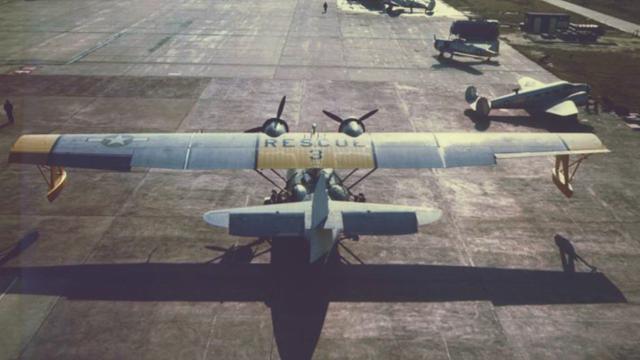September 19, 2011

The answer: versatility.
The Catalina could do just about anything assigned to it. Originally designed as a patrol flying boat, certain improvements were made prior to first delivery to turn it into a patrol bomber. As such, in later versions it was able to carry up to 4000lbs of munitions with a range of around 2500 miles and a crew of eight.

Amazingly for a plane that fought through the entire Second World War, the PBY-1 was first delivered in 1936, making it perhaps the oldest plane to last the entire conflict. As one wold expect from a type of that age, it went through many variations. PBY-1 through -4 were mainly differentiated from each other by progressively more powerful engines, beginning with two 900hp Twin Wasps in the -1 and the -4 having 1050hp engines. The last of the "dash-4"s were delivered in 1939. The PBY that we think of when we envision the Catalina was the "dash-5".

Clear acrylic glass blisters replaced hatches for the observer positions in the rear fuselage, and two 1200hp engines using high-octane fuel allowed the Catalina to reach a maximum speed of 196mph. While there's no way anybody would consider that to be fast for a military plane, speed isn't what the PBY was built for. Its primary job was to search large areas of space on missions that could last up to 20 hours in duration. There's no question that it was good at its job.
While in the service of the RAF Coastal Command, a Catalina (flown by a US Navy crew) found the German battleship Bismarck after it had sunk the Hood and evaded Royal Navy searchers. At the time, the Bismarck was less than a day from safety, but because the Cat had found her the Ark Royal was able to put 15 Swordfish torpedo bombers into the air, one of which damaged the big ship's rudder, sealing its fate.

At the Battle of Midway Catalinas did double-duty, both patrolling and attacking. PBYs were the first units of the US Navy to spot the oncoming Japanese Invasion Fleet on June 3rd, 1942. After an ineffectual high-level bombing attack by B-17s, Catalinas carrying two torpedoes each attacked at night early on June 4th. One torpedo hit the tanker Akebono Maru in the bows, causing light damage. While insignificant to the outcome of the battle as a whole, this strike was the only successful American torpedo attack during the entire Battle of Midway.

PBYs were also amongst the first planes to strike the Japanese stronghold at Rabaul. While hardly the plane of choice for bombing missions over heavily defended targets, there were few other Allied aircraft available in the New Guinea theatre with the range to approach Rabaul. Surprisingly, casualties were light, mostly because the Cats would attack at night and glide in with their engines off or at idle, thereby depriving anti-aircraft gunners of reference points to aim for.

While it was successful enough as a patrol bomber, the Catalina made itself loved in the Search And Rescue role. Such missions, called "Dumbos" by PBY crews (a term that is still used for SAR missions to this day), pulled thousands of pilots and ship crews out of the water and returned them to terra firma. It was a Catalina that rescued most of the pilots of Fighting-8 after their "Flight To Nowhere" at Midway, for example... and coincidentally proved that the Hornet's after-action report was falsified to save the career of Stanhope Ring, but that's a different story for a different day. The most incredible Dumbo mission, however, had to be that of then-Lieutenant Adrian Marks. On August 2nd, 1945, Marks was notified of a large number of men in the water some distance from Guam. After finding the location he dropped inflatable rafts and supplies to them. Seeing some of the sailors attacked by sharks, Marks disobeyed standing orders and landed his Catalina in heavy seas, a maneuver the PBY was nominally unable to do. His crew began plucking survivors from the USS Indianapolis from the ocean. After the plane's fuselage was full of water-logged men, Marks' crew pulled more and more out, lashing them to the wings so they wouldn't fall off. Marks' eventual tally was fifty-six rescued, roughly 1/6th of the total survivors from that tragic disaster.

After the war, PBY-5a (the first amphibious Cat) and dash-6s continued in service in the US Navy, Coast Guard and Army (as the OA-10) as late as the 1960s. In civilian use, Catalinas are still in service as fire-fighting water bombers and passenger planes. There are more than 30 Cats known to be flying world-wide, some 75 years after the Consolidated Model 28 first rolled out of its hangar. Not too bad for an ugly, ungainly plane that couldn't fly particularly well, but could do just about anything you asked of it.

Not bad at all.
Posted by: Wonderduck at
07:45 PM
| Comments (10)
| Add Comment
Post contains 896 words, total size 6 kb.
One of the air museums up here has a Catalina on display. Probably Tillamook, but it might be at Evergreen. It's not as big in person as you'd expect, but then few of the World War II planes are. I remember being amazed the first time I saw a B-17 static display sitting next to an F-15 or maybe an F-14 that was nearly the same size.
I'm now curious to learn how they handled certain inevitable events on a 20 hour mission on this plane and others that had similarly long missions in those days.
Posted by: David at September 19, 2011 09:17 PM (Kn54v)
Posted by: Wonderduck at September 19, 2011 09:33 PM (o45Mg)
A PBY had a galley and I'm pretty sure it had a toilet. Just a hole in the hull beneath the seat, of course.
But one of the things that the Dumbo missions used to do when they pulled a man out of the water was to serve him a hot meal.
Posted by: Steven Den Beste at September 19, 2011 11:13 PM (+rSRq)
Posted by: Steven Den Beste at September 19, 2011 11:22 PM (+rSRq)
Except in modern PBYs... there's one flying out of Durban that has a full bathroom (minus tub/shower) with a standard-looking commode.
I'm sure you're right, Steven, about the hole, except... well, flying boat. Maybe they just went into the bilge.
Posted by: Wonderduck at September 19, 2011 11:57 PM (o45Mg)
Thanks, brother. The Cat has always been near and dear to my heart (I just LOVE butt-ugly aircraft!) - and the thought of paintin' one black and hangin' lousy-operating torps off it to hunt Nips at night freezes the marrow in my bones. Do you know anywhere I could buy a ride? Already have notched a Ford Trimotor, T-6, and B-17...
Now tell the story about Ring. Swede Larsen already seems to have been a perfect rectum - and I'd like to see how Stanhope measures up to him. Looking forward to your next posting.
Posted by: The Old Man at September 20, 2011 12:47 PM (TcNy+)
Reading the post about the PBY (For those who do not know, 'Catalina' was the name the British gave the PBY when they started to receive them. Unlike the Martlet, it stuck with the Americans.), I was reminded of one of the odder little tales to come out of the WW2, namely of the Dutch PBYs that spent time as part of Midway's aircraft complement following Pearl Harbor. And it was a PBY of the Royal Canadian Air Force which located the Kido Butai when the Japanese started their first Indian Ocean Raid.
The Australian also used the PBY as airborne minelayer in the Solomons, New Guinea, and South-East Asia, as well as a covert transport for supply coastwatchers and other parties behind enemy lines.
C.T.
Posted by: cxt217 at September 20, 2011 02:32 PM (D0JxA)
The British are responsible for a lot of the names we hold near and dear. They named the Mustang, for example. They were the ones that named most of our tanks e.g. Sherman, Sheridan, Grant, Lee.
That's because the US Army wasn't into those kinds of names early in the war. The US Navy was, though, and it was Americans that chose names like Hellcat and Corsair.
Posted by: Steven Den Beste at September 20, 2011 06:59 PM (+rSRq)
Posted by: Avatar_exADV at September 20, 2011 07:57 PM (pWQz4)
I do not believe the British ever used 'Sheridan' as the name of a tank. They used 'Stuart' though, for the M3 light tanks.
As for whether it was politic - the US Army had already named some bases after Confederate officers (Fort Bragg comes to mind.), so why not name a tank after the one of the best?
The US Navy was obviously different from the US Army in giving names, though it seemed to have adopted names a bit (Catalina, obviously, and IIRC, 'Helldiver' for the SB2C was suggested by the manufacturer.).
And related to what Wonderduck commented - as much as Stanhope Ring's performance left much to be desired at Midway, I would add Marc Mitscher as another officer who fell short. The main difference between Mitscher and Ring was that Mitscher received a better reputation.
Posted by: cxt217 at September 20, 2011 09:09 PM (D0JxA)
47 queries taking 0.2295 seconds, 286 records returned.
Powered by Minx 1.1.6c-pink.









